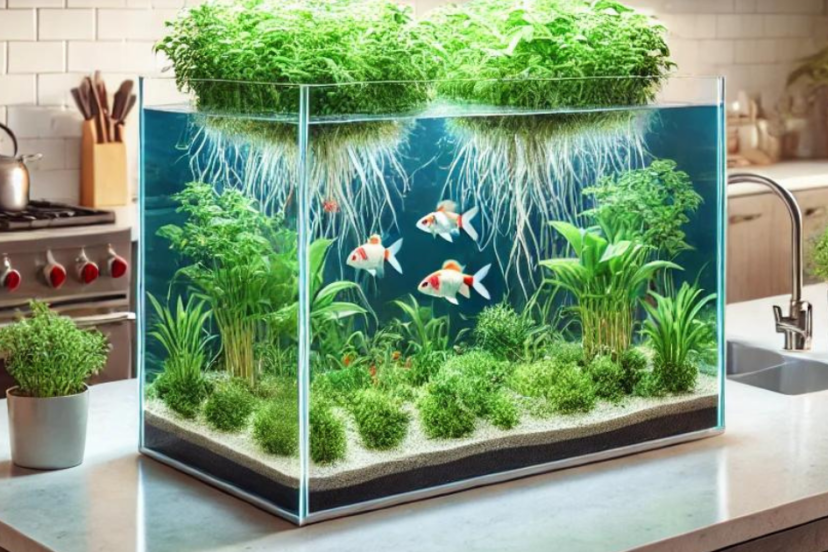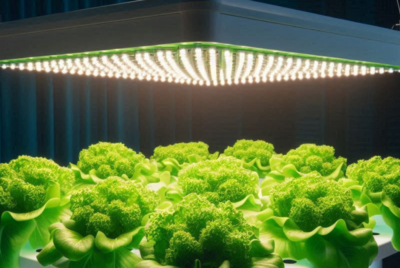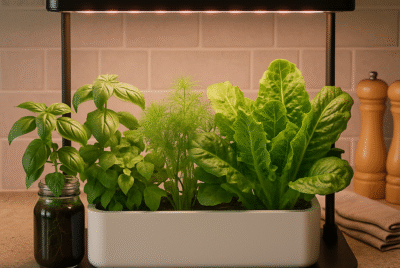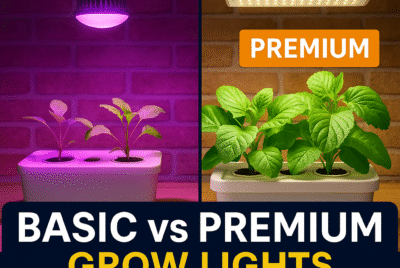Hydroponic Aquarium: Life in full Bloom
What is a Hydroponic Aquarium?
A hydroponic aquarium, in essence, combines the principles of hydroponics and aquariums to create a symbiotic environment where plants and fish co-exist (also know as aquaponics). In this setup, plants are grown in water, without soil, while fish live in the same water, creating a natural and mutually beneficial ecosystem. The fish waste provides nutrients for the plants, and the plants help purify the water for the fish.
Hydroponic aquariums are a fascinating blend of science and art, offering both aesthetic appeal and practical benefits. They bring the beauty of aquatic life and the freshness of green plants into your home, creating a vibrant and dynamic living space.
Why Choose a Hydroponic Aquarium?
Hydroponic aquariums are not just about visual appeal; they offer numerous benefits that make them a worthwhile investment. Here are five compelling reasons to choose a hydroponic aquarium:
1. Sustainability: Hydroponic aquariums create a self-sustaining environment where fish and plants support each other, reducing the need for external inputs and minimizing waste.
2. Healthier Living Space: The plants in a hydroponic aquarium act as natural air purifiers, improving the air quality in your home by absorbing pollutants and releasing oxygen.
3. Educational Value: Hydroponic aquariums provide a hands-on learning experience, making them an excellent educational tool for both children and adults interested in biology, ecology, and sustainable living.
4. Therapeutic Benefits: The calming effect of watching fish swim and plants grow can reduce stress and promote relaxation, enhancing your overall well-being.
5. Space Efficiency: Hydroponic aquariums are ideal for small spaces, as they combine two hobbies (fishkeeping and gardening) into one compact system, making the most of limited room.
Setting Up Your Hydroponic Aquarium
Choosing the Right Tank
The first step in setting up your hydroponic aquarium is selecting the right tank. Here are five recommendations to help you choose the best tank for your needs:
1. Size Matters: A larger tank is generally more stable and easier to maintain. Aim for at least a 20-gallon tank to provide enough space for both plants and fish.
2. Material: Glass tanks are more scratch-resistant and provide a clearer view, but acrylic tanks are lighter and more durable. Choose the material that best fits your needs and budget.
3. Shape: Rectangular tanks are more common and provide better surface area for oxygen exchange, while cylindrical tanks offer a unique look but may require more specialized equipment.
4. Accessibility: Ensure the tank has a wide opening or removable lid for easy access during maintenance and planting.
5. Location: Place the tank in a location that avoids direct sunlight to prevent algae growth, and ensure it’s on a sturdy surface that can support the weight when filled with water.
Essential Equipment Needed
To create a thriving hydroponic aquarium, you’ll need a few essential pieces of equipment. Here are five recommendations to ensure you have everything you need:
1. Water Pump: A reliable water pump is crucial for circulating water and ensuring the roots of your plants receive adequate oxygen. Choose a pump with adjustable flow rates to match your tank size.
2. Air Pump and Air Stone: These help oxygenate the water, promoting healthy fish and plant growth. An air stone connected to an air pump will produce a steady stream of bubbles, increasing oxygen levels.
3. Grow Lights: Adequate lighting is essential for plant growth. LED grow lights are energy-efficient and provide the full spectrum of light needed for photosynthesis. Position the lights above the tank and set them on a timer for 10-12 hours of light per day.
4. Filtration System: A good filtration system helps maintain water quality by removing debris and harmful chemicals. Choose a filter rated for your tank size and consider a combination of mechanical, chemical, and biological filtration for best results.
5. Heater (if needed): Depending on the type of fish you choose, you may need a heater to maintain a stable water temperature. Tropical fish require warmer water, usually between 75-80°F.
Selecting the Right Plants
Choosing the right plants for your hydroponic aquarium is crucial for creating a balanced ecosystem. Here are five plant recommendations that thrive in a hydroponic setup:
1. Basil: This herb is easy to grow and quickly adapts to hydroponic systems. It requires moderate light and adds a pleasant aroma to your living space.
2. Mint: Mint grows vigorously in hydroponic systems and is great for controlling water quality. It prefers bright, indirect light and regular pruning to prevent overgrowth.
3. Lettuce: Lettuce varieties like Romaine and Butterhead are ideal for hydroponic aquariums. They grow quickly and require moderate light and nutrient levels.
4. Spinach: Spinach is another excellent choice, known for its rapid growth and nutritional value. It thrives in cooler water temperatures and moderate light.
5. Watercress: This aquatic plant naturally grows in water and is well-suited for hydroponic systems. It requires ample light and can help filter the water, keeping it clean for the fish.
Choosing the Right Fish
Selecting the right fish is just as important as choosing the right plants. Here are five fish species that are well-suited for hydroponic aquariums:
1. Guppies: These small, colorful fish are hardy and adapt well to various water conditions. They are livebearers, meaning they give birth to live young, adding more life to your tank.
2. Tetras: Tetras, such as Neon Tetras and Cardinal Tetras, are peaceful and thrive in community tanks. They prefer slightly acidic water and moderate temperatures.
3. Bettas: Betta fish, known for their vibrant colors and flowing fins, are excellent for hydroponic aquariums. They require warmer water and prefer to be kept alone or with non-aggressive tankmates.
4. Zebra Danios: These active fish are easy to care for and adapt well to various water conditions. They are excellent for beginners and prefer to be kept in schools of five or more.
5. Mollies: Mollies are versatile and can live in both freshwater and brackish water. They are livebearers and enjoy a planted tank environment.
Balancing Your Hydroponic Aquarium
Understanding the Nitrogen Cycle
The nitrogen cycle is a fundamental concept for maintaining a healthy hydroponic aquarium. Here are five recommendations to help you understand and manage the nitrogen cycle effectively:
1. Cycle Your Tank Before Adding Fish: Before introducing fish, ensure your tank has gone through the nitrogen cycle. This process typically takes 4-6 weeks and involves the growth of beneficial bacteria that convert ammonia to nitrites and then to nitrates.
2. Monitor Ammonia Levels: Ammonia is toxic to fish and should be closely monitored. Use a reliable test kit to check ammonia levels regularly, especially during the initial cycling period.
3. Establish Beneficial Bacteria: Beneficial bacteria play a crucial role in the nitrogen cycle. Introduce a bacterial supplement or use filter media from an established tank to speed up the cycling process.
4. Avoid Overfeeding: Overfeeding can lead to excess waste and higher ammonia levels. Feed your fish small amounts once or twice a day, and remove any uneaten food after a few minutes.
5. Regular Water Changes: Perform regular water changes to dilute ammonia and nitrite levels. During the cycling period, change 10-20% of the water weekly to maintain water quality.
Maintaining Water Quality
Maintaining optimal water quality is essential for the health of your plants and fish. Here are five recommendations to ensure your water stays clean and balanced:
1. Regular Testing: Test your water regularly for key parameters such as pH, ammonia, nitrites, and nitrates. Keeping a log of your results can help you track changes and address issues promptly.
2. pH Stability: Maintain a stable pH level suitable for your fish and plants. Most hydroponic aquariums thrive with a pH between 6.5 and 7.5. Use pH buffers if necessary to adjust the
levels. Avoid sudden pH changes, as they can stress both plants and fish.
3. Water Hardness: Monitor the hardness of your water, which includes General Hardness (GH) and Carbonate Hardness (KH). Most plants and fish do well in moderate hardness, but some species may require specific conditions. Adjust hardness using commercial products or natural methods like adding crushed coral for KH.
4. Filtration Maintenance: Regularly clean and maintain your filtration system. Replace filter media as needed and ensure that mechanical, chemical, and biological filtration components are functioning properly. A clean filter helps keep the water free of debris and harmful substances.
5. Avoid Contaminants: Be mindful of what you introduce into your tank. Avoid using soaps or chemicals near the aquarium, and always wash your hands thoroughly before working with the tank. When adding new plants or decorations, rinse them well to remove any potential contaminants.
Balancing Light and Nutrients
Achieving the right balance of light and nutrients is critical for healthy plant growth. Here are five recommendations to help you find this balance:
1. Appropriate Lighting: Use LED grow lights designed for aquatic plants. Ensure that the lights provide the full spectrum of light needed for photosynthesis. Position the lights about 12 inches above the tank and use a timer to maintain consistent light cycles, typically 10-12 hours per day.
2. Avoid Excessive Light: Too much light can lead to algae growth. If you notice algae starting to take over, reduce the light intensity or duration. Also, avoid placing the tank in direct sunlight, which can exacerbate algae issues.
3. Nutrient Management: Use hydroponic fertilizers specifically formulated for aquatic plants. These fertilizers provide essential nutrients like nitrogen, phosphorus, and potassium. Follow the manufacturer’s instructions to avoid over-fertilizing, which can harm both plants and fish.
4. CO2 Supplementation: Some plants benefit from additional CO2. Consider using a CO2 injection system or CO2 tablets to enhance plant growth. Monitor CO2 levels to ensure they remain safe for fish.
5. Pruning and Maintenance: Regularly prune your plants to remove dead or decaying leaves. This helps prevent nutrient imbalances and keeps your tank looking tidy. Trim fast-growing plants to prevent them from overshadowing slower-growing species.
Benefits of Hydroponic Aquariums

Healthier Plants and Fish
Hydroponic aquariums offer numerous health benefits for both plants and fish. Here are five reasons why this system promotes healthier living organisms:
1. Natural Filtration: Plants in a hydroponic aquarium act as natural filters, absorbing harmful substances like ammonia, nitrites, and nitrates. This reduces the stress on fish and creates a cleaner, healthier environment.
2. Oxygen Production: Aquatic plants produce oxygen through photosynthesis, which helps maintain high oxygen levels in the water. This is crucial for fish health, as it supports their respiration and overall well-being.
3. Balanced Ecosystem: The symbiotic relationship between plants and fish creates a balanced ecosystem where each benefits the other. Fish waste provides nutrients for plants, while plants help keep the water clean and oxygenated.
4. Reduced Disease Risk: Healthy plants contribute to a stable environment, reducing the likelihood of sudden water parameter changes that can stress fish and make them more susceptible to disease. A well-maintained hydroponic aquarium can lead to fewer outbreaks of common fish diseases.
5. Improved Fish Behavior: Fish in hydroponic aquariums often exhibit more natural behaviors. The presence of plants provides shelter and hiding spots, reducing stress and promoting healthier interactions among tank inhabitants.
Reduced Maintenance
One of the significant advantages of hydroponic aquariums is the reduced maintenance required compared to traditional setups. Here are five ways hydroponic systems can save you time and effort:
1. Self-Sustaining System: The natural filtration provided by plants reduces the need for frequent water changes. With a well-balanced hydroponic aquarium, you can extend the interval between water changes, typically performing partial changes every 2-4 weeks.
2. Algae Control: Properly managed hydroponic aquariums experience less algae growth due to the competition for nutrients. Plants absorb excess nutrients that would otherwise fuel algae blooms, leading to a cleaner tank.
3. Automated Systems: Many hydroponic aquariums can be equipped with automated systems for feeding, lighting, and CO2 injection. These systems help maintain consistent conditions and reduce the daily maintenance tasks required.
4. Simplified Filtration: The combination of biological filtration from plants and mechanical filtration from your filter system creates a more efficient cleaning process. Regular maintenance of the filter system is still necessary, but the overall workload is reduced.
5. Less Chemical Use: With the natural balance achieved in a hydroponic aquarium, there’s less need for chemical treatments to address water quality issues. This reduces the risk of chemical imbalances and makes maintenance simpler.
Eco-Friendly Option
Hydroponic aquariums are an environmentally friendly choice for several reasons. Here are five ways they contribute to sustainability:
1. Water Conservation: Hydroponic systems use less water compared to traditional soil-based gardening and separate aquariums. The closed-loop system recycles water, minimizing waste and conserving this precious resource.
2. Reduced Chemical Runoff: By using hydroponic fertilizers and avoiding soil, hydroponic aquariums reduce the risk of chemical runoff into the environment. This helps protect natural water bodies from pollution.
3. Energy Efficiency: Modern LED grow lights and efficient water pumps consume less energy than traditional lighting and equipment. This reduces the carbon footprint of maintaining your aquarium.
4. Sustainable Food Production: If you choose to grow edible plants like herbs and vegetables in your hydroponic aquarium, you can enjoy fresh produce without the need for soil or pesticides. This promotes sustainable and organic food production.
5. Biodiversity Support: Hydroponic aquariums can support a diverse range of plant and fish species, promoting biodiversity. By creating a healthy and balanced ecosystem, you contribute to the preservation of various species.
Common Challenges and Solutions
Algae Growth
Algae growth is a common challenge in hydroponic aquariums, but it can be managed effectively. Here are five recommendations to control algae:
1. Control Light Exposure: Algae thrive on light. Ensure your tank is not exposed to direct sunlight and use a timer to limit artificial light to 10-12 hours per day.
2. Nutrient Management: Excess nutrients, especially nitrates and phosphates, fuel algae growth. Avoid overfeeding fish and use fertilizers sparingly. Regular water changes can help keep nutrient levels in check.
3. Introduce Algae Eaters: Certain fish and invertebrates, such as snails, shrimp, and algae-eating fish like Siamese Algae Eaters, can help control algae naturally by grazing on it.
4. Manual Removal: Regularly clean the tank walls and decorations to remove algae. Use an algae scraper or brush to keep surfaces clean. Vacuum the substrate during water changes to remove algae spores.
5. Add Competing Plants: Fast-growing plants can outcompete algae for nutrients, reducing algae growth. Consider adding floating plants like duckweed or water lettuce to your tank.
Nutrient Imbalance
Nutrient imbalances can harm both plants and fish in a hydroponic aquarium. Here are five ways to address nutrient imbalances:
1. Regular Testing: Test water parameters regularly to monitor nutrient levels. Keep track of nitrates, phosphates, and other essential nutrients. Adjust your fertilization routine based on test results.
2. Balanced Fertilization: Use hydroponic fertilizers designed for aquatic plants and follow the manufacturer’s guidelines. Avoid over-fertilizing, which can lead to nutrient toxicity and algae growth.
3. Supplementing Nutrients: If your plants show signs of nutrient deficiencies (e.g., yellowing leaves), supplement with specific nutrients as needed. Common deficiencies include iron, potassium, and magnesium.
4. Water Changes: Regular water changes help dilute excess nutrients and prevent imbalances. Change 10-20% of the water weekly to maintain a stable environment.
5. Adjust Feeding Practices: Overfeeding fish can contribute to nutrient imbalances. Feed your fish only what they can consume in a few minutes and remove any uneaten food promptly.
Fish Health Issues
Maintaining fish health is crucial in a hydroponic aquarium. Here are five recommendations to keep your fish healthy:
1. Quarantine New Fish: Always quarantine new fish for at least two weeks before adding them to your main tank. This helps prevent the introduction of diseases and parasites.
2. Monitor Fish Behavior: Regularly observe your fish for signs of stress or illness, such as lethargy, loss of appetite, or abnormal swimming behavior. Early detection of issues allows for prompt treatment.
3. Maintain Water Quality: Good water quality is essential for fish health. Perform regular water changes, maintain appropriate filtration, and monitor water parameters to prevent stress and disease.
4. Provide a Balanced Diet: Feed your fish a varied and balanced diet to ensure they receive all the necessary nutrients. Include high-quality commercial fish food, live or frozen foods, and vegetable matter.
5. Avoid Overcrowding: Overcrowding can lead to stress and increased risk of disease. Follow recommended stocking levels for your tank size and provide plenty of hiding spots and territory for each fish.
Personal Tips and Tricks
Monitoring Water Parameters
Keeping a close eye on water parameters is key to a successful hydroponic aquarium. Here are five tips for effective monitoring:
1. Use Quality Test Kits: Invest in reliable water test kits to measure parameters like pH, ammonia, nitrites, nitrates, GH, and KH. Regular testing helps you catch issues early.
2. Keep a Log:
Document your test results in a logbook or digital spreadsheet. Tracking changes over time helps you identify trends and make informed decisions about your aquarium maintenance.
3. Set a Routine: Establish a regular schedule for testing water parameters. Weekly checks are ideal for most tanks, but you may need to test more frequently if you notice any issues.
4. Understand Ideal Ranges: Familiarize yourself with the ideal water parameter ranges for your specific fish and plants. Aim to keep parameters within these ranges to promote health and stability.
5. Prompt Action: If you detect any deviations from the ideal ranges, take corrective action immediately. This may involve adjusting the pH, performing water changes, or altering your fertilization routine.
Best Plant and Fish Combinations
Choosing compatible plants and fish ensures a harmonious and thriving hydroponic aquarium. Here are five recommendations for successful combinations:
1. Guppies and Java Moss: Guppies are active and peaceful fish that thrive with the addition of Java Moss. Java Moss provides hiding spots for guppy fry and helps filter the water.
2. Tetras and Amazon Sword Plants: Tetras, such as Neon Tetras and Cardinal Tetras, enjoy the cover provided by Amazon Sword Plants. These plants create a natural and aesthetically pleasing environment for the tetras.
3. Bettas and Anubias: Betta fish appreciate the broad leaves of Anubias plants, which offer resting spots. Anubias are hardy and low-maintenance, making them ideal for a betta tank.
4. Zebra Danios and Water Wisteria: Zebra Danios are active swimmers that benefit from the dense foliage of Water Wisteria. This plant provides ample cover and helps maintain water quality.
5. Mollies and Hornwort: Mollies thrive in tanks with Hornwort, a fast-growing plant that helps control algae and provides a natural habitat for the fish. Hornwort also absorbs excess nutrients, keeping the water clean.
DIY Projects for Your Hydroponic Aquarium
Enhance your hydroponic aquarium experience with creative DIY projects. Here are five ideas to get you started:
1. DIY Plant Holders: Create custom plant holders using PVC pipes, suction cups, or floating rafts. These holders keep plants in place and allow for easy repositioning and maintenance.
2. Aquaponic Grow Beds: Build a grow bed above your aquarium to expand your hydroponic setup. Use a shallow container filled with hydroponic media to grow herbs and vegetables, with water from the aquarium circulating through the bed.
3. CO2 Reactor: Construct a DIY CO2 reactor using a plastic bottle, tubing, and yeast. This simple setup provides a steady supply of CO2 for your plants, promoting healthier growth.
4. Custom LED Light Setup: Design and install a custom LED light setup tailored to your tank’s dimensions and plant needs. Use programmable LEDs to create different lighting schedules and intensities.
5. Aquarium Background: Create a stunning 3D background for your tank using materials like foam, cement, and silicone. A custom background adds depth and visual interest to your aquarium while providing hiding spots for fish.
Conclusion
Recap of Key Points
A hydroponic aquarium offers a unique and sustainable way to enjoy both fishkeeping and gardening. By combining aquatic plants and fish in a symbiotic environment, you create a balanced ecosystem that benefits both organisms. Setting up a hydroponic aquarium involves choosing the right tank, equipment, plants, and fish, and maintaining water quality and nutrient balance. The benefits of hydroponic aquariums include healthier plants and fish, reduced maintenance, and an eco-friendly footprint. Overcoming common challenges like algae growth and nutrient imbalances is crucial for success. Personal tips and DIY projects can further enhance your hydroponic aquarium experience.
If you’re looking for a rewarding and sustainable hobby, a hydroponic aquarium is an excellent choice. The combination of aquatic life and greenery creates a beautiful and serene environment in your home. With the right setup and maintenance, you’ll enjoy the benefits of a thriving, self-sustaining ecosystem. So why not give it a try? Dive into the world of hydroponic aquariums and discover the joys of this innovative approach to fishkeeping and gardening.
FAQs
What is the best type of fish for a hydroponic aquarium?
Guppies, Tetras, Bettas, Zebra Danios, and Mollies are among the best fish for a hydroponic aquarium. They are hardy, adapt well to various water conditions, and coexist peacefully with aquatic plants.
How often should I change the water in my hydroponic aquarium?
In a well-balanced hydroponic aquarium, partial water changes of 10-20% are typically performed every 2-4 weeks. Regular testing of water parameters will help determine the optimal schedule for your specific setup.
Can I use any plant in a hydroponic aquarium?
Not all plants are suitable for hydroponic aquariums. Choose aquatic or semi-aquatic plants like Java Moss, Amazon Sword Plants, Anubias, Water Wisteria, and Hornwort. These plants thrive in water and contribute to the ecosystem’s balance.
What are the signs of a healthy hydroponic aquarium?
Signs of a healthy hydroponic aquarium include clear water, vibrant plant growth, active and healthy fish, stable water parameters (pH, ammonia, nitrites, nitrates), and minimal algae growth.
Is a hydroponic aquarium suitable for beginners?
Yes, a hydroponic aquarium can be suitable for beginners. Start with hardy fish and low-maintenance plants, and gradually expand your knowledge and setup as you gain experience. Proper research and regular maintenance are key to success.
*We may earn a commission from purchases made through our links, at no cost to you. This does not affect our product recommendations. Please see our disclosure to learn more.




